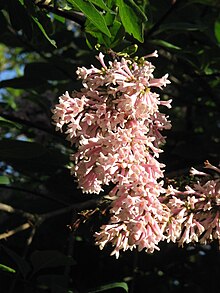Felt lilac
| Felt lilac | ||||||||||||
|---|---|---|---|---|---|---|---|---|---|---|---|---|

Felted lilac ( Syringa tomentella ) |
||||||||||||
| Systematics | ||||||||||||
|
||||||||||||
| Scientific name | ||||||||||||
| Syringa tomentella | ||||||||||||
| Bureau & Franch. |
The Woolly lilacs ( Syringa tomentella ) is a shrub with pale lilac pink flowers from the family of Olive Family (Oleaceae). The natural range is in China. The species is often used as an ornamental shrub.
description
The felty lilac is a 1.5 to 7 meter high, slender shrub with sparsely to densely hairy branches. Terminal buds are present. The leaves have a 0.8 to 1.5 centimeter long, hairy, shaggy hairy or balding stalk. The leaf blade is simple, 2.5 to 11 inches long and 1.5 to 5 inches wide, elliptical-lanceolate to ovate-lanceolate, rarely ovoid or obovate, with a pointed to acuminate tip and a wedge-shaped or more or less rounded base. The upper side of the leaf is lush green, hairy or glabrous when pressed, the underside is hairy like the twigs or bearded along the veins .
The flowers grow in 10 to 25 centimeters long and 4 to 12 centimeters diameter, upright, terminal or rarely lateral, loose and leafy panicles . Like the 1 to 1.5 millimeter long peduncle and the calyx, the inflorescence axis is hairy, shaggy hairy or balding. The calyx is 2.5 to 3 millimeters long. The corolla is 1 to 1.7 inches wide and red-purple, pink or white. The corolla tube is slightly funnel-shaped and 0.8 to 1.4 inches long. The corolla lobes are ovate to elliptical and are spread out. The anthers are yellow and extend to the throat of the corolla tube or a little beyond it. The flowers are fragrant. When fruits are 1.2 and 2 centimeters long, oblong-elliptical, smooth or significantly with Korkporen occupied capsules formed. The felty lilac flowers from June to July, the fruits ripen in September.
distribution
The natural range is in the west of the Chinese province of Sichuan . The felty lilac grows in forests on mountain slopes, in thickets in valleys or along gorges at altitudes of 2500 to 3500 meters on well-drained, fresh to moist, acidic to neutral, sandy or gritty-humic, moderately nutrient-rich soils in sunny to light-shady locations . The species loves warmth and is usually frost hardy .
Systematics
The Woolly Lilac ( Syringa tomentella ) is a kind of the genus of Lilac ( Syringa ) in the family of Oleaceae (Oleaceae). There the genus is assigned to the tribe Oleeae. The species was first scientifically described by Louis Édouard Bureau and Adrien René Franchet in 1891 . The genus name Syringa was chosen by Linnaeus in 1753, previously from around the 16th century the name was used both for the common lilac ( Syringa vulgaris ) and for the European pipe bush ( Philadelphus coronarius ). It was probably derived from the Greek "syrigs", a wind instrument that can be made from the branches of the pipe bush. The specific epithet tomentella comes from Latin and means "fine felted". It refers to the leaves that are sometimes densely tomentose.
One can distinguish several subspecies:
- Syringa tomentella subsp. tomentella : It occurs in western Sichuan. The chromosome numbers given are 2n = 46 and 2n = 48.
- Syringa tomentella subsp. yunnanensis (Franch.) Jin Y.Chen & DYHong (Syn .: Syringa yunnanensis Franch. ): It occurs from southeastern Tibet to southwestern Sichuan and northwestern Yunnan. The number of chromosomes is 2n = 44.
- Syringa tomentella subsp. sweginzowii (Koehne & Lingelsh.) Jin Y.Chen & DYHong : It is also used by some authors as a separate species Syringa sweginzowii Koehne & Lingelsh. viewed. It occurs from southeastern Tibet to western Sichuan.
use
The felty lilac is often used as an ornamental shrub because of its decorative and fragrant flowers .
proof
literature
- Wu Zheng-yi, Peter H. Raven (Ed.): Flora of China . Volume 15: Myrsinaceae through Loganiaceae . Science Press / Missouri Botanical Garden Press, Beijing / St. Louis 1996, ISBN 0-915279-37-1 , pp. 283 (English).
- Andreas Roloff , Andreas Bärtels: Flora of the woods. Purpose, properties and use. With a winter key from Bernd Schulz. 3rd, corrected edition. Eugen Ulmer, Stuttgart (Hohenheim) 2008, ISBN 978-3-8001-5614-6 , p. 644.
- Jost Fitschen: Woody flora . 12th, revised and expanded edition. Quelle & Meyer, Wiebelsheim 2007, ISBN 3-494-01422-1 , p. 828 .
- Helmut Genaust: Etymological dictionary of botanical plant names. 3rd, completely revised and expanded edition. Nikol, Hamburg 2005, ISBN 3-937872-16-7 (reprint from 1996).
Individual evidence
- ↑ German name according to Roloff et al .: Flora der Gehölze , p. 644 and after Fitschen: Gehölzflora , p. 828
- ↑ a b c d Roloff et al .: Flora der Gehölze , p. 644
- ↑ a b c d Mei-chen Chang, Lien-ching Chiu, Zhi Wei, Peter S. Green: Syringa tomentella , in the Flora of China , Volume 15, p. 283
- ↑ a b c Syringa tomentella. In: Germplasm Resources Information Network (GRIN). United States Department of Agriculture, accessed July 2, 2012 .
- ↑ Exactly: Etymological Dictionary of Botanical Plant Names , p. 625
- ↑ Exactly: Etymological Dictionary of Botanical Plant Names , p. 648
- ↑ a b c Rafaël Govaerts (Ed.): Syringa tomentella. In: World Checklist of Selected Plant Families (WCSP) - The Board of Trustees of the Royal Botanic Gardens, Kew . Retrieved December 10, 2017.
- ↑ Syringa yunnanensis at Tropicos.org. In: IPCN Chromosome Reports . Missouri Botanical Garden, St. Louis
Web links
- Syringa tomentella. In: The Plant List. Retrieved July 2, 2012 .
